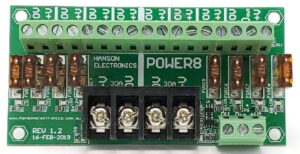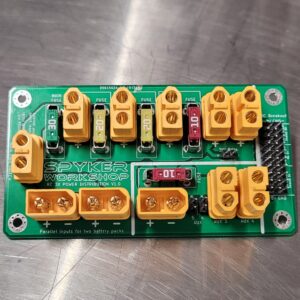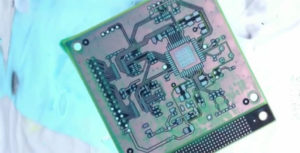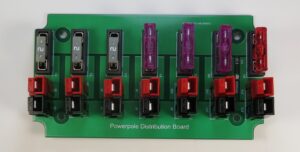Industrial robot arm power distribution boards are not generic PCBs—they feature:
-
High copper weight (often 2oz to 6oz) to handle continuous high current
-
Heavy-duty components like power MOSFETs, IGBTs, and connectors
-
Multi-zone thermal design for heat dissipation
-
Mixed-voltage levels with careful isolation between logic and power circuits
Reconstructing these designs requires careful attention to not only geometry but also material specifications, dielectric properties, and soldering techniques. Errors in trace width, hole alignment, or component placement can cause overheating, short circuits, or mechanical incompatibilities.
Once the dimensional analysis and design recreation are complete, we generate the necessary Gerber data, BOM list, and CAD files for manufacturing. Our engineers oversee prototype production to ensure the reproduced PCB board performs identically to the original, meeting all electrical, mechanical, and thermal specifications.

Quando i file di progettazione originali, come file Gerber, diagrammi schematici o disegni di layout, vengono persi o non sono disponibili, l’analisi dimensionale del reverse engineering delle schede PCB diventa un passaggio essenziale nel processo di clonazione o rigenerazione. Il nostro servizio è specializzato nel reverse engineering delle schede di distribuzione dell’alimentazione utilizzate nei bracci robotici industriali, con particolare attenzione alla precisione dimensionale, alla fedeltà elettrica e alla compatibilità meccanica. Queste schede sono spesso personalizzate in modo univoco per specifiche piattaforme robotiche e qualsiasi tentativo di replicarle, duplicarle o modificarle senza misurazioni precise può portare a guasti catastrofici o a prestazioni ridotte.
We also support modifications and upgrades during this process, allowing clients to improve upon the original design by integrating better materials, more efficient layouts, or additional functionality—all while maintaining compatibility with the existing robotic system.
Unique Challenges in Power Distribution PCB Reverse Engineering
Industrial robot arm power distribution boards are not generic PCBs—they feature:
-
High copper weight (often 2oz to 6oz) to handle continuous high current
-
Heavy-duty components like power MOSFETs, IGBTs, and connectors
-
Multi-zone thermal design for heat dissipation
-
Mixed-voltage levels with careful isolation between logic and power circuits
Reconstructing these designs requires careful attention to not only geometry but also material specifications, dielectric properties, and soldering techniques. Errors in trace width, hole alignment, or component placement can cause overheating, short circuits, or mechanical incompatibilities.

Gerber dosyaları, şematik diyagramlar veya düzen çizimleri gibi orijinal tasarım dosyaları kaybolduğunda veya kullanılamadığında, PCB Board Tersine Mühendislik Boyutsal Analizi klonlama veya yeniden üretim sürecinde önemli bir adım haline gelir. Hizmetimiz, endüstriyel robotik kollarda kullanılan güç dağıtım panolarının tersine mühendisliğinde uzmanlaşmıştır ve boyutsal doğruluk, elektriksel sadakat ve mekanik uyumluluğa özel bir odaklanma vardır. Bu panolar genellikle belirli robotik platformlar için benzersiz bir şekilde özelleştirilir ve bunları hassas ölçüm yapılmadan kopyalama, çoğaltma veya değiştirme girişimi felaketle sonuçlanan arızalara veya düşük performansa yol açabilir.
Conclusion
PCB Board Reverse Engineering Dimensional Analysis is a critical component of restoring, modifying, or replicating industrial robotic arm power distribution PCBs. By leveraging precision tools, deep expertise, and rigorous engineering processes, we help industries extend the life of their robotic systems, reduce downtime, and regain control over legacy or undocumented hardware.
PCB Board Reverse Engineering Dimensional Analysis objective refers to the electronic/mechanical components on the Printed circuit board, the dimensions define the size and shape of the part and locate all part features.
Tolerances describe the dimensional limits to facilitate manufacturing while ensuring proper fit and function of parts or assemblies. A dimensional analysis should be conducted on all electronic/mechanical piece-parts/components. Parts that could not be disassembled previously may be cross-sectioned and cut away if necessary to establish the dimensional data.

PCB Board Reverse Engineering Dimensional Analysis
Considerations
The following should be considered when performing the PCB Board Reverse Engineering Dimensional Analysis:
1st is Bearing housings and shaft fits should be noted. When they are not in accordance with standard recommended practices in the bearing manufacturer’s catalog, additional bearing seats and tolerances should be reviewed and investigated. The variation could be a manufacturing error or done deliberately for some engineering purpose.
2nd is Assumptions concerning screw threads should be avoided since manufacturers often produce unique threads to prevent others from copying them or substituting standard threaded parts. The pitch diameter should be measured and compared to the classes provided in Federal Standard H28/18.
3rd is All clearances should be measured and noted to assist in the tolerance of individual parts. These should include, but are not limited to:
(1) Lateral movement,
(2) Backlash (gears and splines).
(3) Torque,
(4) Operating loads (i.e., handles), and
(5) Keyway clearances.

Когда оригинальные файлы дизайна, такие как файлы Gerber, принципиальные схемы или чертежи компоновки, утеряны или недоступны, PCB Board Reverse Engineering Dimensional Analysis становится важным шагом в процессе клонирования или восстановления. Наша служба специализируется на обратном проектировании плат распределения питания, используемых в промышленных роботизированных манипуляторах, уделяя особое внимание точности размеров, электрической точности и механической совместимости. Эти платы часто изготавливаются по индивидуальному заказу для конкретных роботизированных платформ, и любая попытка скопировать, дублировать или модифицировать их без точного измерения может привести к катастрофическим отказам или снижению производительности.






